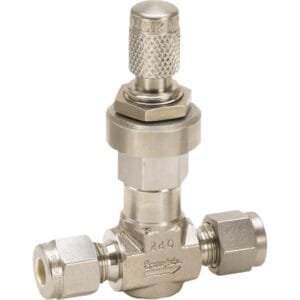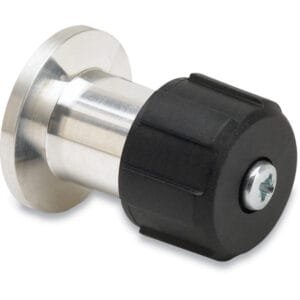Auto-Soft Flow Actuated Check Valves (KF Flanged)
TFM’s Auto-Soft flow actuated check valves are designed to replace a KF centering ring, facilitating easy installation and effective throttling of roughing pumps during initial evacuation. When the roughing pump operates, the initial flow causes the vane assembly to close, automatically regulating the pump’s performance. The valves then reopen automatically when a predetermined pressure differential is achieved.
Key Features
- Durable Construction: Made from 304 stainless steel with an Elgiloy® spring for enhanced durability and corrosion resistance.
- Temperature Tolerance: Capable of operating at a maximum temperature of 100°C.
- Reduced Turbulence: Minimizes turbulence in the system by lowering the initial pumping speed, which is especially beneficial in sensitive applications.
- Application Versatility: Ideal for environments sensitive to particle disruption, such as semiconductor and thin film manufacturing.
- Complementary Use: Can be used with vent valves when venting a system to mitigate extreme pressure differentials and minimize turbulence.
- Substrate Protection: Helps prevent damage to substrates during the pumping process.
- Cost-Effective: Replaces expensive pressure control bypass valves, offering a more economical solution.
- Fast Action: Features fast-action vane closing, achieving closure in 12 ms or better during testing.
- No Electrical Power Required: Operates effectively without the need for electrical power.
Performance Notes
- The typical pump-down time using the soft start check valve is increased by three times.
- Test results, measured using a 27 CFM pump evacuating a volume of 100 liters, may vary based on the specific system configuration.
Specifications Table
| Manufacturer | |
|---|---|
| Rates | Closing Flow 6.00 CFM 2.80 L/s Opening Pressure 2.67 mbar 2.00 Torr |
| Temperature | Bakeable 100 ºC 212 ºF |
| Actuator Type | Spring |
| Spring Material | Elgiloy |
| Bearing Material | Teflon |
| Vane Material | Inconel 625 |
| Valve Body Material | 304L SS |
| Valve Seal Material | Viton |
Ordering Table
| Flange Size | Closing Time (sec.) | Required Clearance (in.) | Part Number |
| KF40 (2.16″ OD) | 0.01 | 0.7 | 225-0040 |
| KF50 (2.95″ OD) | 0.012 | 1 | 225-0050 |





Reviews
There are no reviews yet.